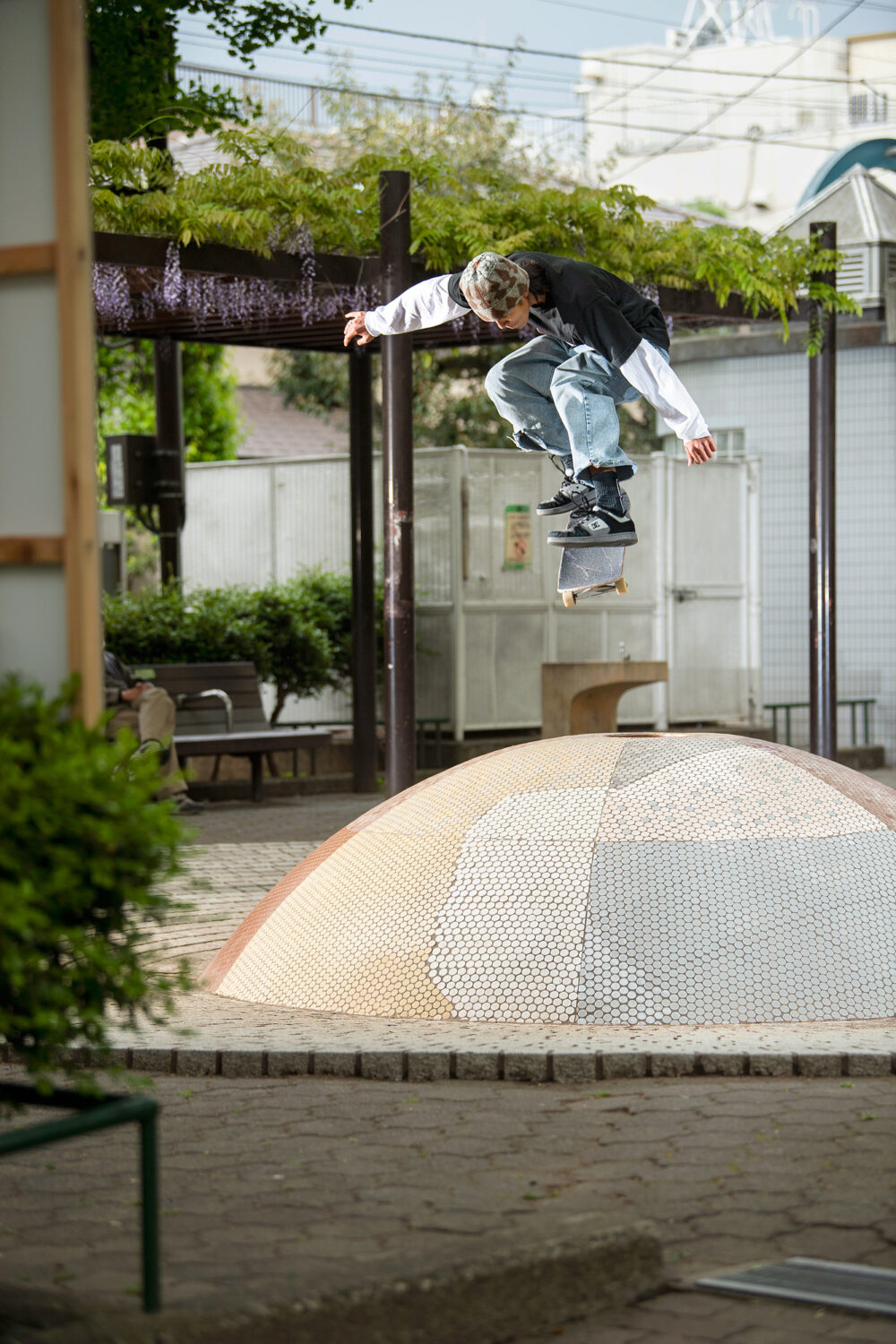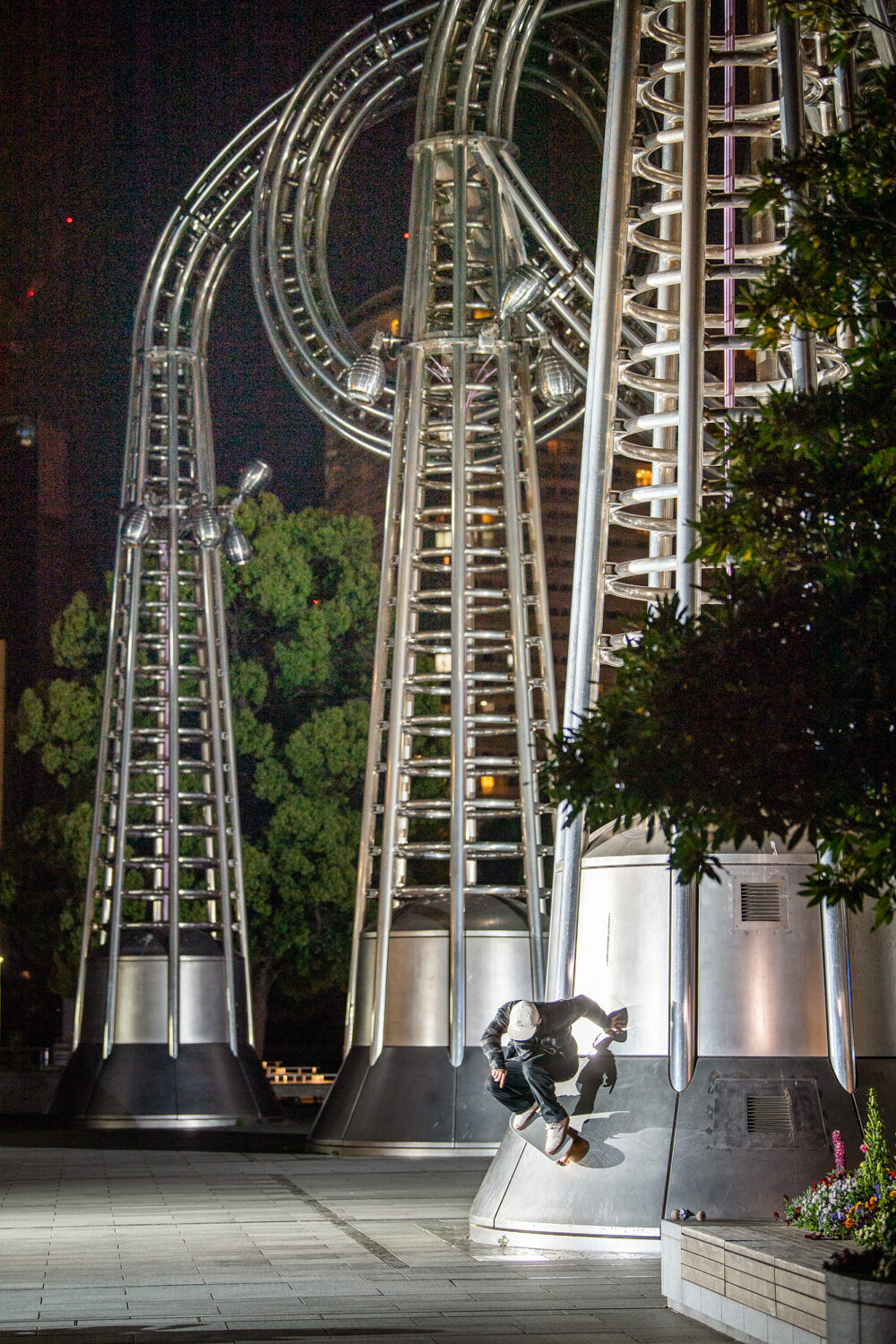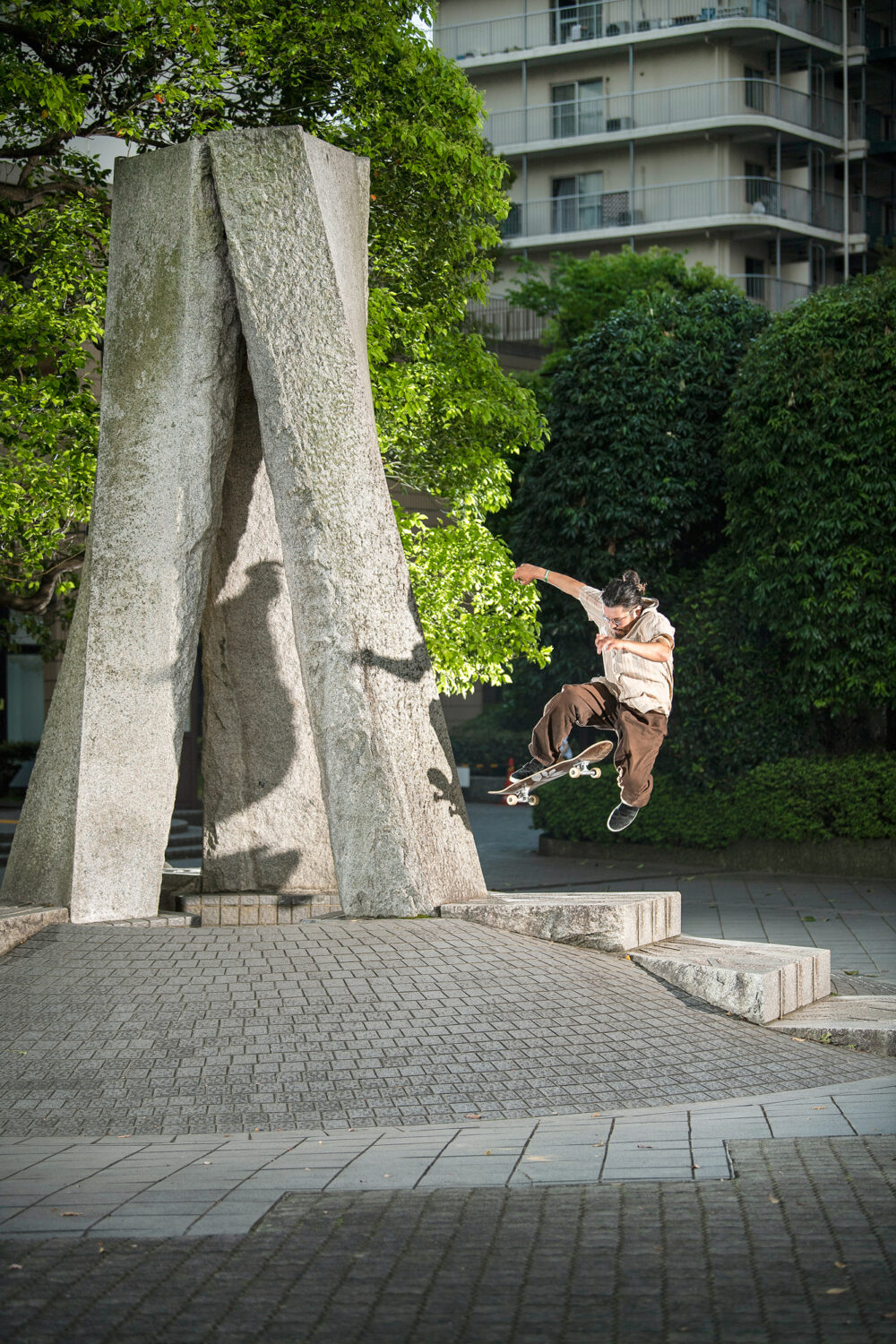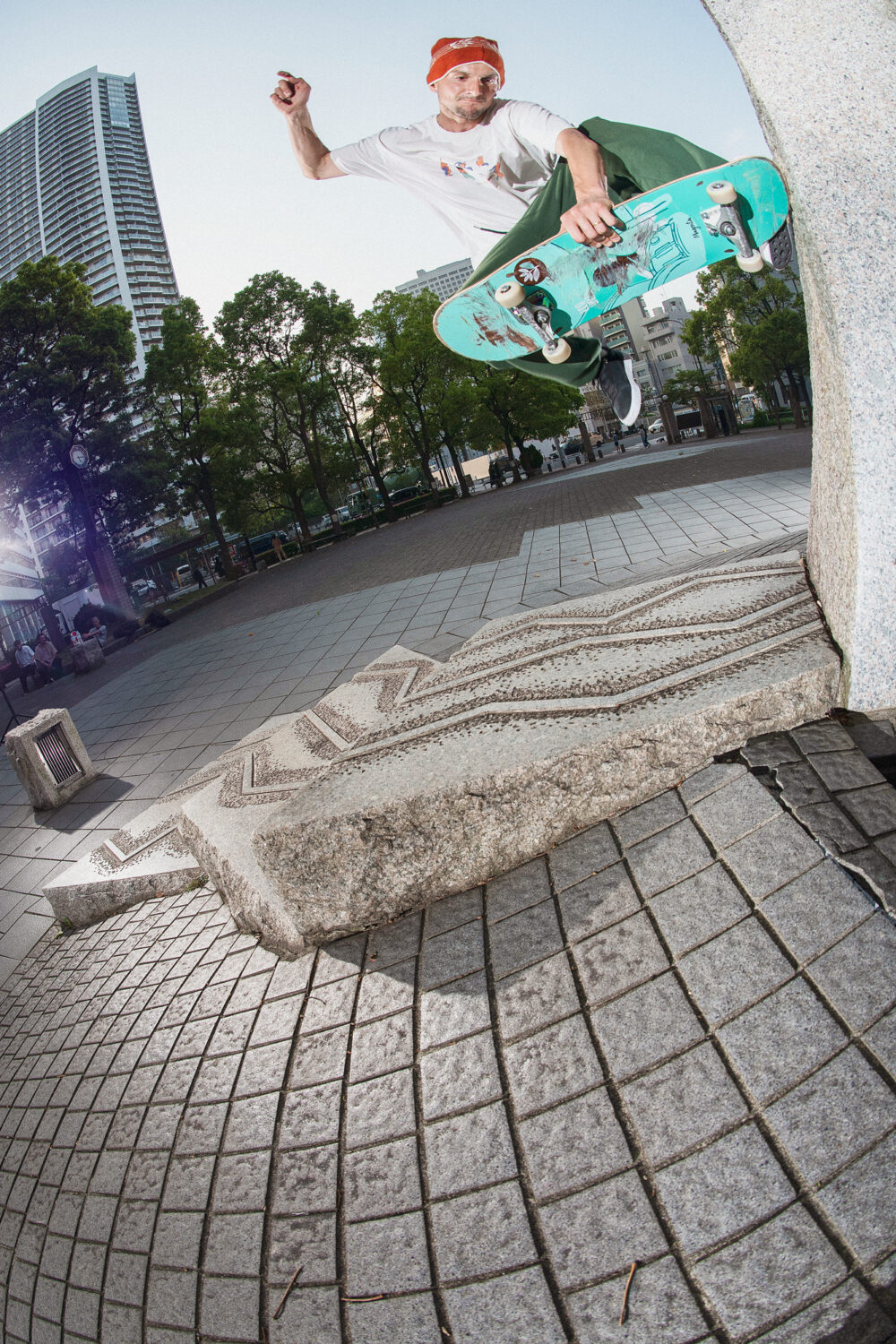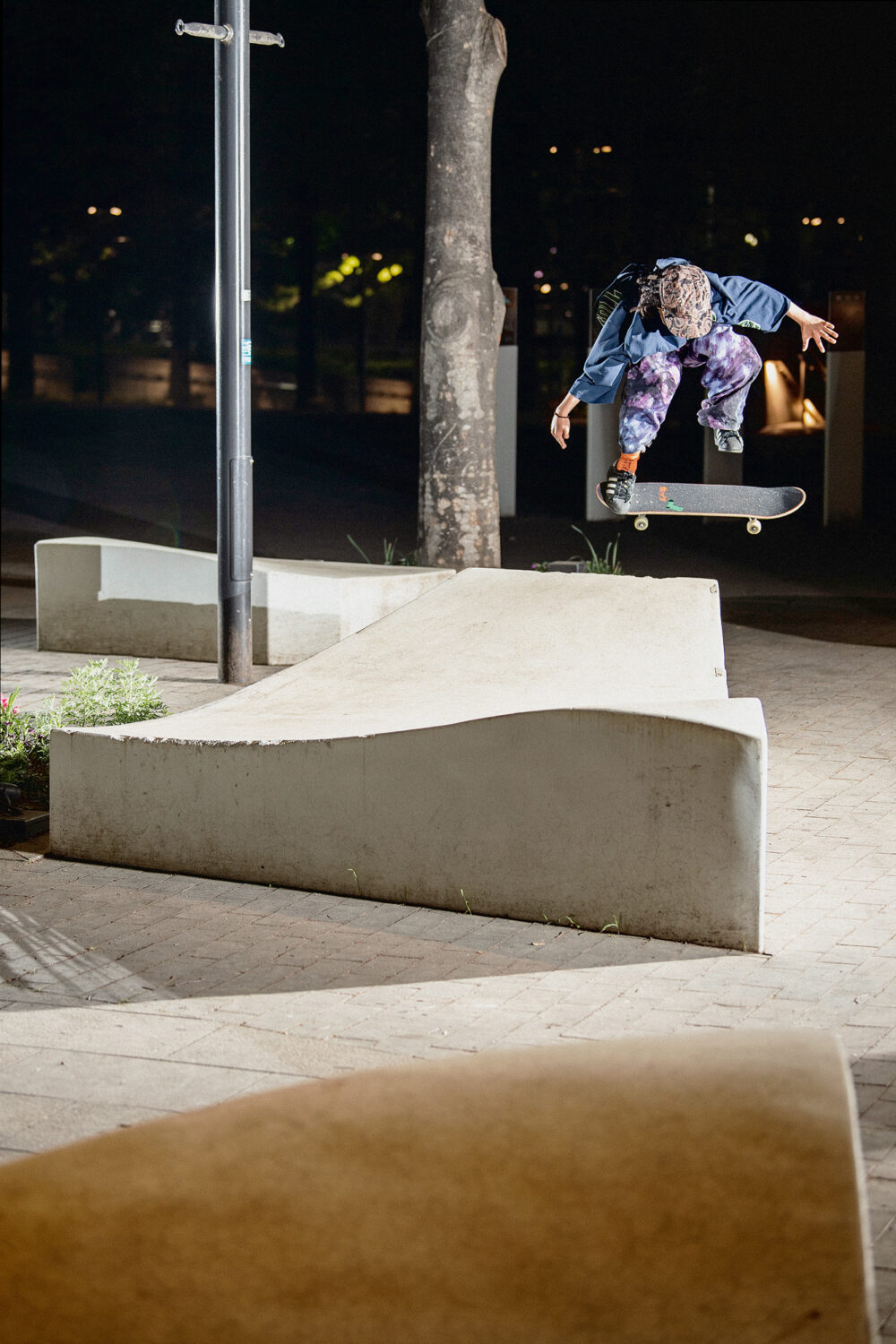Feature: Monstro de Tokyo
26.09.2023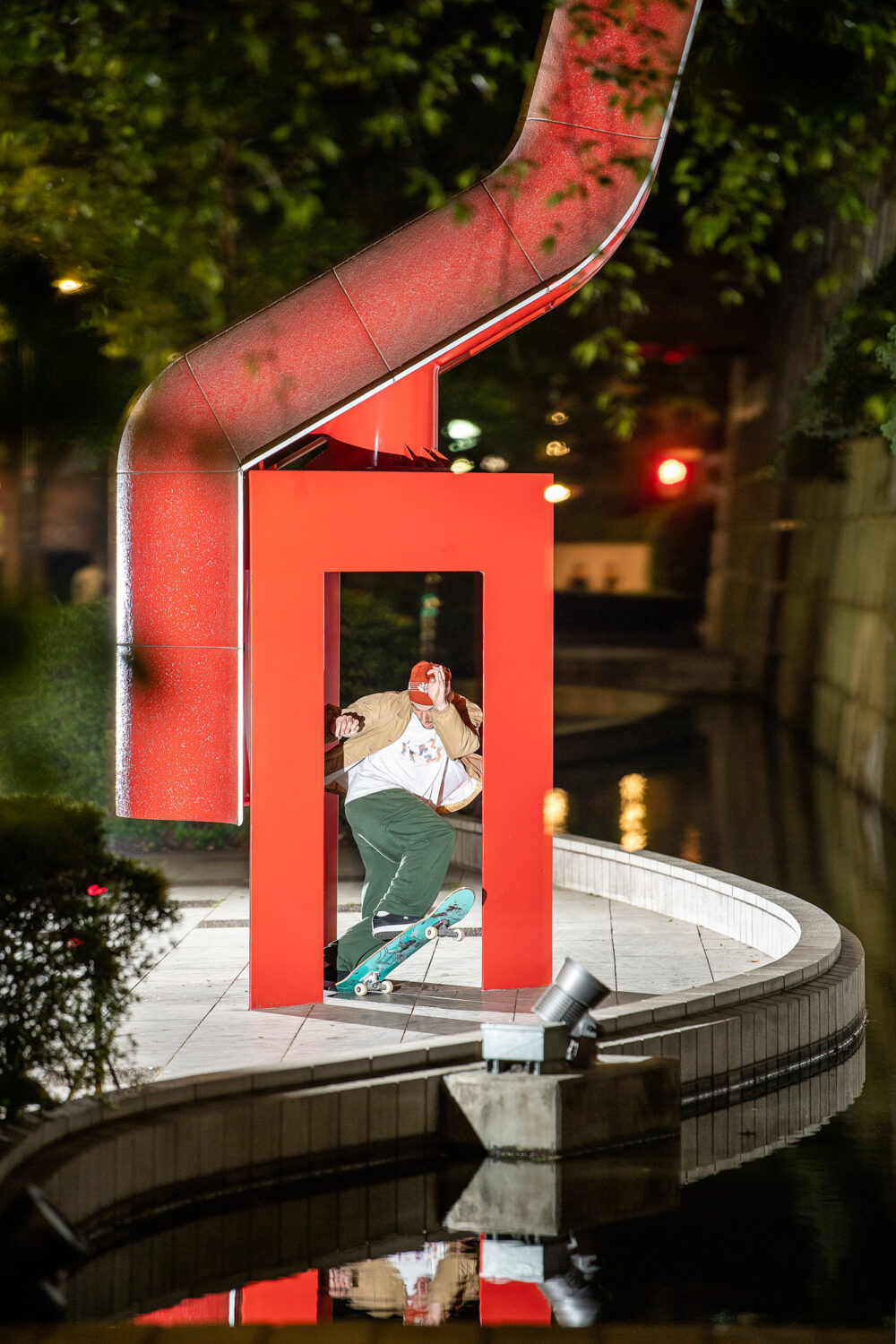
Photography: Iseki
Interview: Kingsford
An interview with Tokyo-based photographer Nobuo Iseki, filmmaker Rémi Luciani and skateboarder and consultant in skateboarding and public space Leo Valls.
Tell us about the Monstro project.
L – Monstro is a travel skate video series that was started organically between myself and Rémi, who I met a while ago when he was living in Marseille and filming the scene there. I’ve always been a fan of his work. The Monstro series is about travelling, connecting and being creative while capturing the specific energy of a city. Our goal is to go places, connect with locals and showcase the unique vibe of a place. We have been doing this skateboard thing for a while now and we are specifically interested in the unique style and flavour coming from different cities and places around the world, very much connected to the cultural and architectural background of these very places.
R – We made the first episode of Monstro back in 2018. Leo invited me to me to spend a week in Bordeaux to film a short video together. Sergio Santoro – who’s from Rio de Janeiro – happened to be on a Euro trip at the same time and ended up joining us in Bordeaux. The connection between us three was instant and we filmed what became Monstro de Rua, the first episode of the series.
The mindset behind Monstro is to create connections with like-minded skaters worldwide. We like to show the energy of spontaneous creative skating on spots that have a unique architecture or look. Last but not least, we love to show the happiness and joy people express during our filming sessions.
Rémi, tell us a little about your background as a filmmaker.
R – I guess it all started in 2009, back when I was 15, skating the streets of a small city in the south of France called Draguignan. I remember one day my friend Guillaume Brofferio brought his mom’s camcorder out during one of our sessions. At that time I was consuming a lot of skate content, as well as cinema feature films. Surely enough, I got inspired with the idea of having my own camcorder and fisheye to document our sessions. Later on, I graduated and moved to Marseille to study filmmaking. Today, besides making skate films, I am a full-time video editor.
Have any particular filmmakers influenced the Monstro films?
R – My main influences from the skateboarding world come from Takahiro Morita, Shinpei Ueno, Shingo Ogura, Greg Hunt, Colin Read and Josh Stewart to name a few. From the world of cinema, which also influences what I do in skate videos, I think of Ron Fricke, Len Lye and Saul Bass.
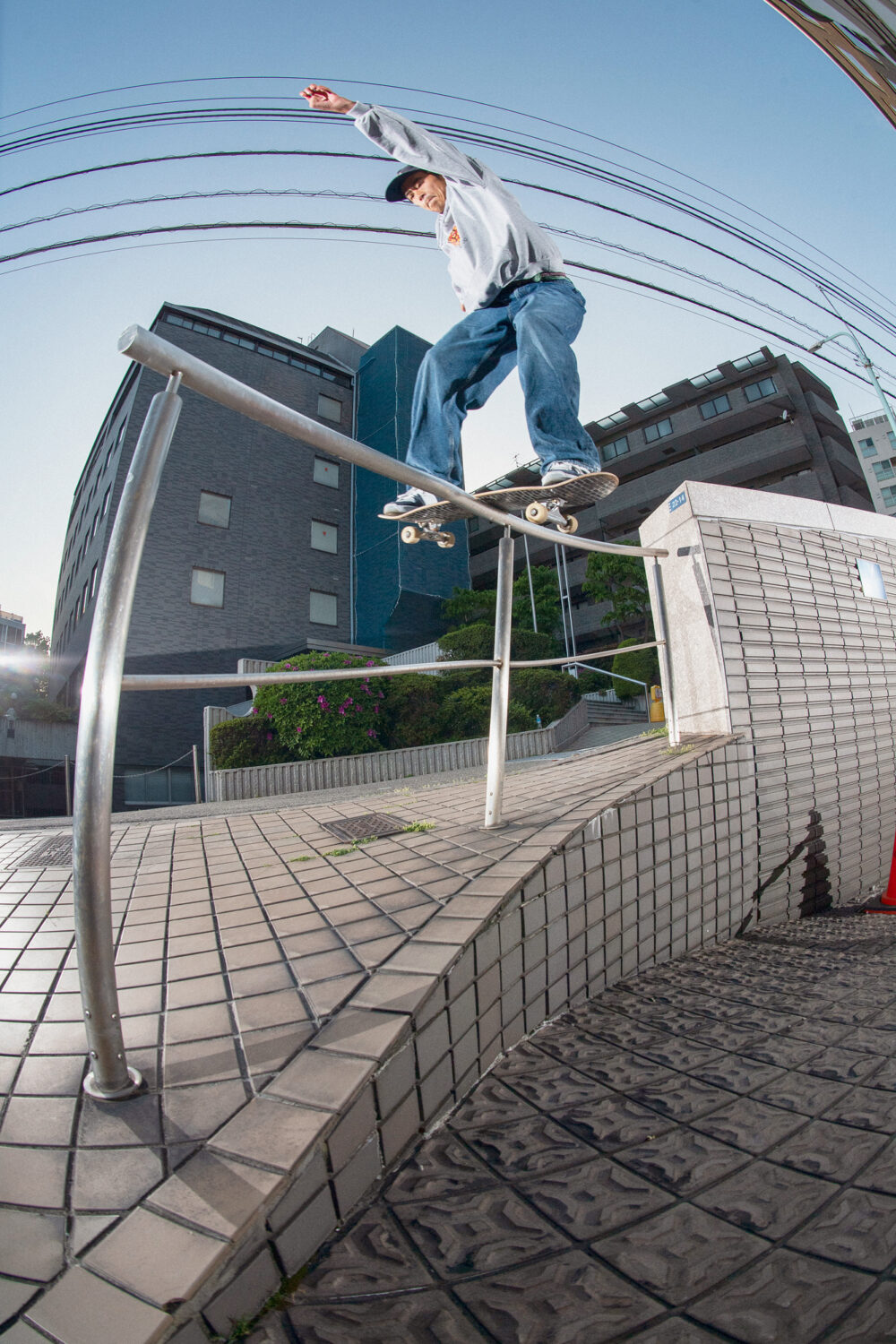
Tell us about the name.
R – Coming back to the filming of Monstro de Rua, Leo was making jokes while we were filming. I remember he was shouting: “Monstro de rua!” to Sergio, which translates as street monster in Portuguese. He later explained to us that it was a reference to Tiago Lemos, who called him that when they were on a DC tour. This sentence stuck in my mind. I thought it could be a good name for the video and suggested we keep it as the title.
What made you choose Tokyo for the latest instalment?
R – This decision came from Leo. He would be better at giving you all the reasons that sparked this idea.
L – Japan has a special place in my heart. In 2015, when I was skating for FESN (Far East Skate Network), I lived in Takahiro Morita’s apartment in Tokyo for a while with my wife. I had the chance to travel across the country a few times and build so many connections there. I knew it would be epic to go back after the pandemic and that many homies would come skate with us.
Leo, this was your 12th visit to Japan. What is it about skating there – specifically Tokyo – that appeals to you?
L – Yes, number 12, damn! I just love the architecture of Tokyo. Everything is skateable and looks sick on footage. People, cars, lights… I love how dense it is there, even though this also means it can be so hard to skateboard. I would say that Tokyo is a dream and a nightmare to skate at the same time. Everything is made of paradoxes in Japan (laughs).
Leo, am I right in thinking Japanese skateboarding has been a big influence on you and your Magenta teammates?
L – For sure, Japan has an incredible street skateboarding scene and culture and I really
appreciate the fact that these guys value creativity, personality, spot seeking and style over the level of stunts. It makes skateboarding more subtle and interesting in my view. In 2008, during my very first visit to the country, I ended up attending the world premiere of Overground Broadcasting, the epic skate movie Takahiro Morita had worked on for seven years – with that crazy Gou Miyagi part – and it was such a powerful motivation and reminder of how infinite and unique skateboarding culture can be.
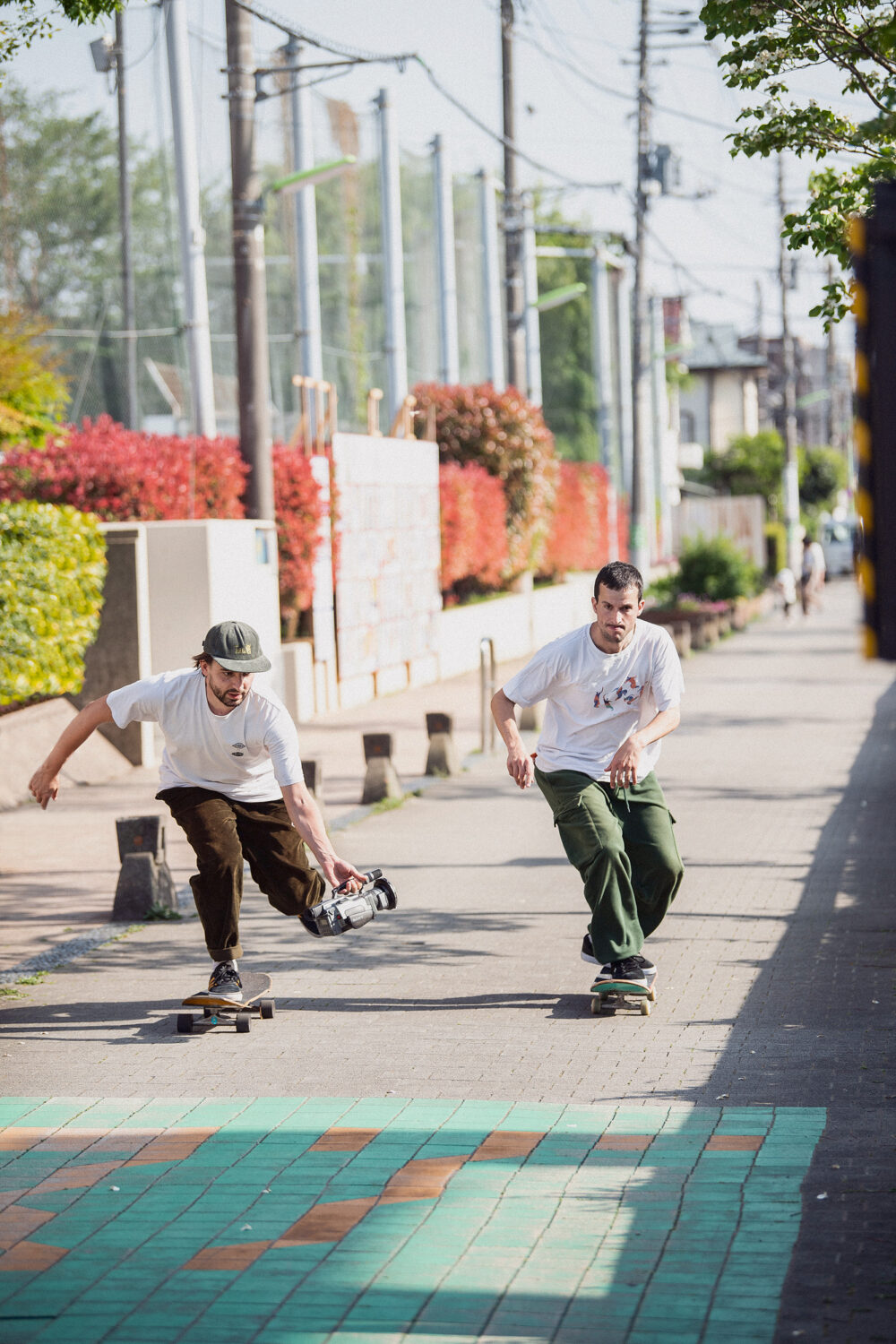
Rémi, this was your first time in Tokyo. What were your first impressions?
R – The first thing I noticed, being in the streets of Tokyo, was that you are continuously stimulated, either visually or by sounds. In the centre of the city you’ll see billboards, neon signs, street signs, logos, lights and advertisements everywhere. Most of them have unique aesthetics using high-contrast colour pairing, bold letters, colourful outlines, blends of Japanese characters and western alphabets… As a filmmaker I found it very inspiring in terms of design.
Regarding the skate scene, I was struck by how polite, humble, respectful and welcoming Japanese skaters are. I feel grateful that I had this chance to meet and collaborate with some of the finest local skaters there.
Nobuo, how did you get involved with the Monstro de Tokyo project?
N – In February or March, Leo messaged me to join him as he was coming to Tokyo to shoot the Monstro series in May. March to May is the best season in Tokyo, so it was good timing!
How did you choose the crew of skaters who were part of this project? Nobuo, did you suggest anyone?
N – Leo already has a lot of friends from Tokyo, so I didn’t suggest anyone. He knows and
connects with the skate community in Tokyo well.
L – I already had a bunch of friends from previous trips that I knew would join, like Akira Imamura who I met 15 years ago – he skates for Evisen. I met Japanese Super Rat (Kento Yoshioka) when he visited me in France not too long ago, so I was hyped to skate with him in Tokyo. Then some other homies joined and I was blown away by their motivation. Stinky Eagle – as he wants to be called – met us in front of our hotel the first morning we went skating at 6am, ready to dodge security guards. What a legend! I met Shintaro Hongo on a DC trip in Europe. He and his brother Masaki were such a treat to skate with.
I take it involving locals is an important part of what you’re doing.
R – Since the first episode in Bordeaux, to the streets of Rio and now Japan, the goal was to capture the essence of a place, its vibe, and of course including locals is fundamental to me in that sense.
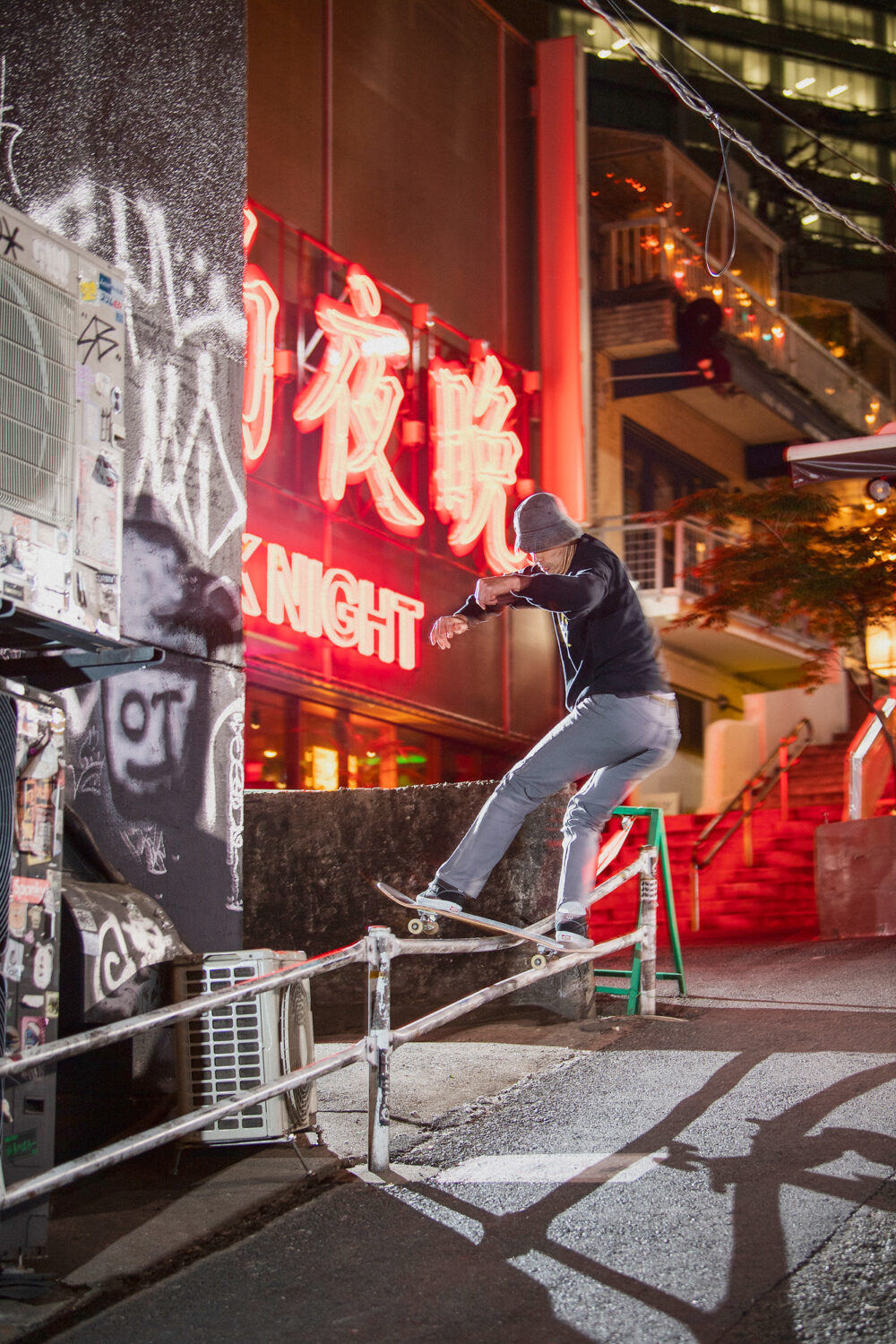
Skating in Tokyo is notoriously difficult because of security and police. Nobuo, can you talk a little about how you approach documenting skateboarding in the city?
N – Yeah, we basically planned the whole process of each day’s shooting. Which spot do we go to? What time is easy to skate? Which is the best way to escape… like that. During these few months (March-May), I learned the 40-minute rule.
What’s that?
N – We start to skate. 15 minutes later people living there notice the skateboard sounds. 15-25 minutes they put up with it. 30 minutes later people call the cops. 40 minutes later the cops arrive. So you have to leave 35 minutes after you start.
Interesting. Rémi, how did you find filming in terms of security and police?
R – We kept Tokyo’s agents busy. If you want to skate the attractive architectural spots in the centre, you are most likely going to get kicked out instantly as lots of them are on the ground floor of businesses, which are guarded. I mean, if we were in the middle of filming something we really wanted, dodging security wasn’t much of a big deal, actually. We would say sorry, leave and come back right after to get the footage.
Nobuo, in your experience, what impact has the 2020 Tokyo Olympic Games – where skateboarding had its Olympic debut – had on street skating in the city?
N – It depends on the spot. In the countryside there has been no change, I guess. Downtown it became harder. We have no tickets for skating but people call the cops more easily. Also I have heard of cases of skaters having to pay for damage caused by skating.
In London I have noticed that the Olympics has made people understand street skating less. The argument: “Why can’t you do that in the skatepark?” is more common now, as that is the environment people saw in the Olympics. Is this an argument you noticed being used in Tokyo?
N – Yes, haters say that.
L – That’s the same problem in many cities around the world unfortunately. In Bordeaux, decades ago, the city developed a repressive policy towards skateboarding by ticketing kids and using skate stoppers right after they built a skatepark. When we started working on making Bordeaux a skate-friendly city, some of the local elected officials would tell us things like: “I play tennis, I do it at the tennis court… You have a skatepark, this has to be the same.” Well it’s obviously not the same…
It takes time to get people to understand that street skating and skateparks are complementary.
The problem is that the Olympics came to Japan and they communicated to the masses about skateboarding being a sport that happens only in a sports field and never about the essence of skateboarding being the streets. Many Tokyo locals explained to us that this made things worse for street skating. We experienced it. We got kicked out by police and security guards all day long, but we noticed a lot of regular pedestrians AKA ‘super citizens’ trying to prevent us from skating, believing they were doing some kind of civic act. We only got to skate almost all the spots you see in the photos in this article for a really short amount of time.
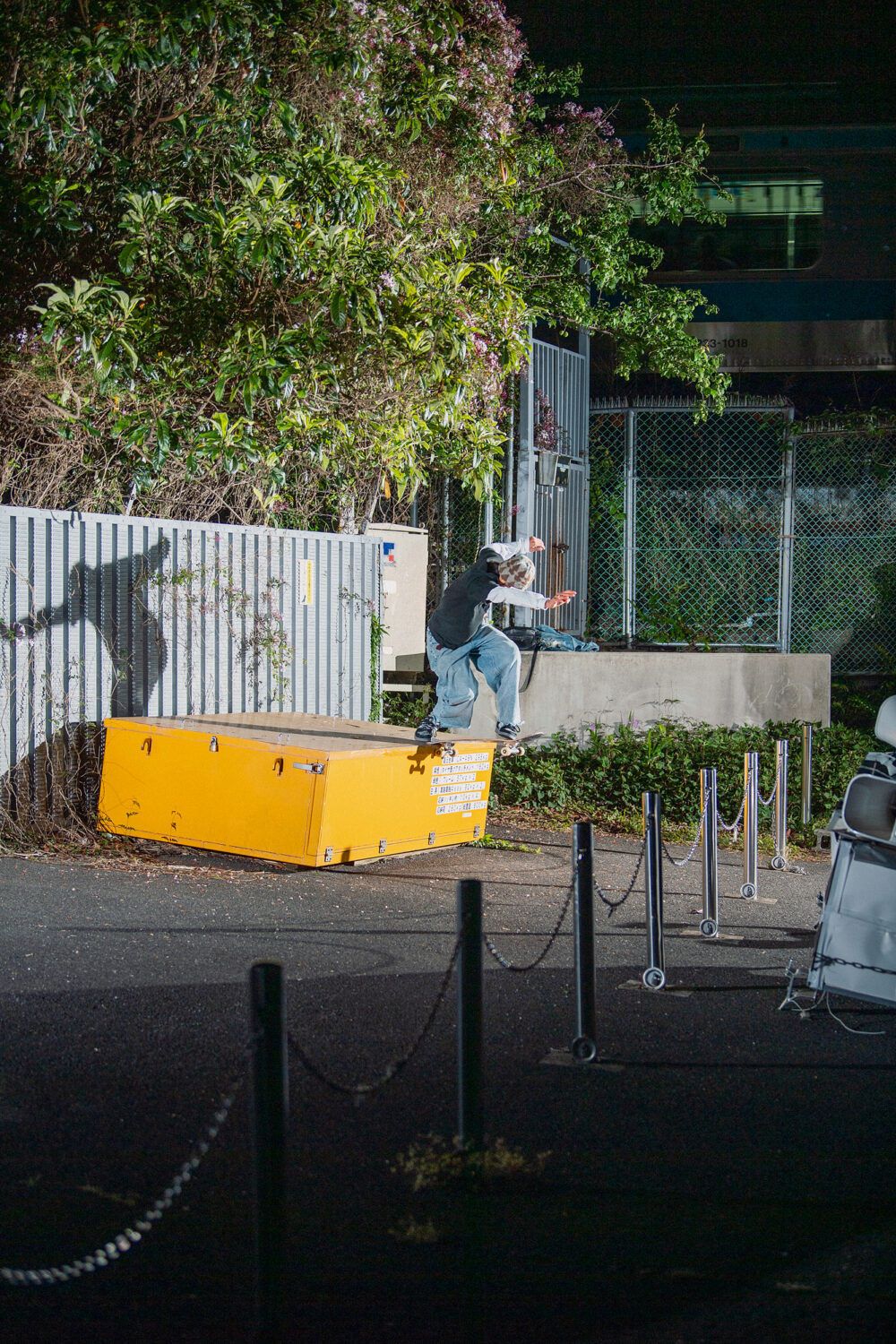
Leo, you were invited by Nikken Sekkei (an influential Tokyo-based architectural, planning and engineering company) to give a talk on skate-friendly cities with reference to your work in Bordeaux, which took place during the Monstro trip. Tell us more about this.
L – Nikken’s architects are interested in the concept of skate urbanism and skate-friendly cities. Some of them visited Bordeaux at the end of last year to check out the street spots we have developed here. They invited me to give a conference on the topic in Tokyo. Knowing the difficult Japanese context, my idea was to simply show a positive example of what’s possible elsewhere by detailing the projects we have done through the years: mediation, skateable sculptures / furniture and skate-friendly public spaces. It was very interesting; many architects and Tokyo government people attended. I invited my friends Yoshiharu Yoshida and Shinpei Ueno as key speakers so they could share their experiences too.
Do you think this indicates a change in attitude and policy towards street skating in Japan?
Do you see the government welcoming skate-friendly, mixed-use architecture and spaces?
N – Yeah, I think it’s a step in the right direction, but it isn’t a government thing. The company and people are changing things step by step. Nikken talking to people and skaters is a big step. They have already made a small skate plaza as their social experiment. Just talking and planning is easy, but doing and realising is so hard.
L – I think it’s gonna take a long time. The main problem is not even the Japanese government, it’s the general public’s belief that skateboarding is very dangerous for other city users. Years of repression and no skateboarding signs everywhere did that. But I think some projects are doable, step by step.
Back to the Monstro de Tokyo mission, what are some of your best memories from that time?
N – One day Leo held a small skate class for 10-15 local kids. They loved him so much. After the class, 4-5 kids followed him on our night mission. We went to a few spots near Leo’s hotel and they helped us by watching for cars and people. I am sure they will remember this mission for a long time too.
L – Probably driving around Tokyo at night in Nobuo’s van and DJing the shit out of it (laughs). Also, the Magenta (Just Cruise 2) video premiere was amazing.
R – Dinner parties at restaurants with 10-15 friends, if not more, sharing delicious food and ice cold beers, Shintaro Hongo’s surprise birthday party in Yokosuka and running into my friend Graham Davies, who’s from England, after many years not seeing him.
Where is the next destination for the Monstro series?
R – Leo and I have already been debating the topic. We both have ideas we would like to make happen, but nothing sure for the moment. Personally, I was thinking of South Africa, Thailand, Hong Kong, New Zealand, San Diego or NYC.
L – For the people reading this: if you have any proposals, hit me up!
Watch Monstro de Tokyo here.
